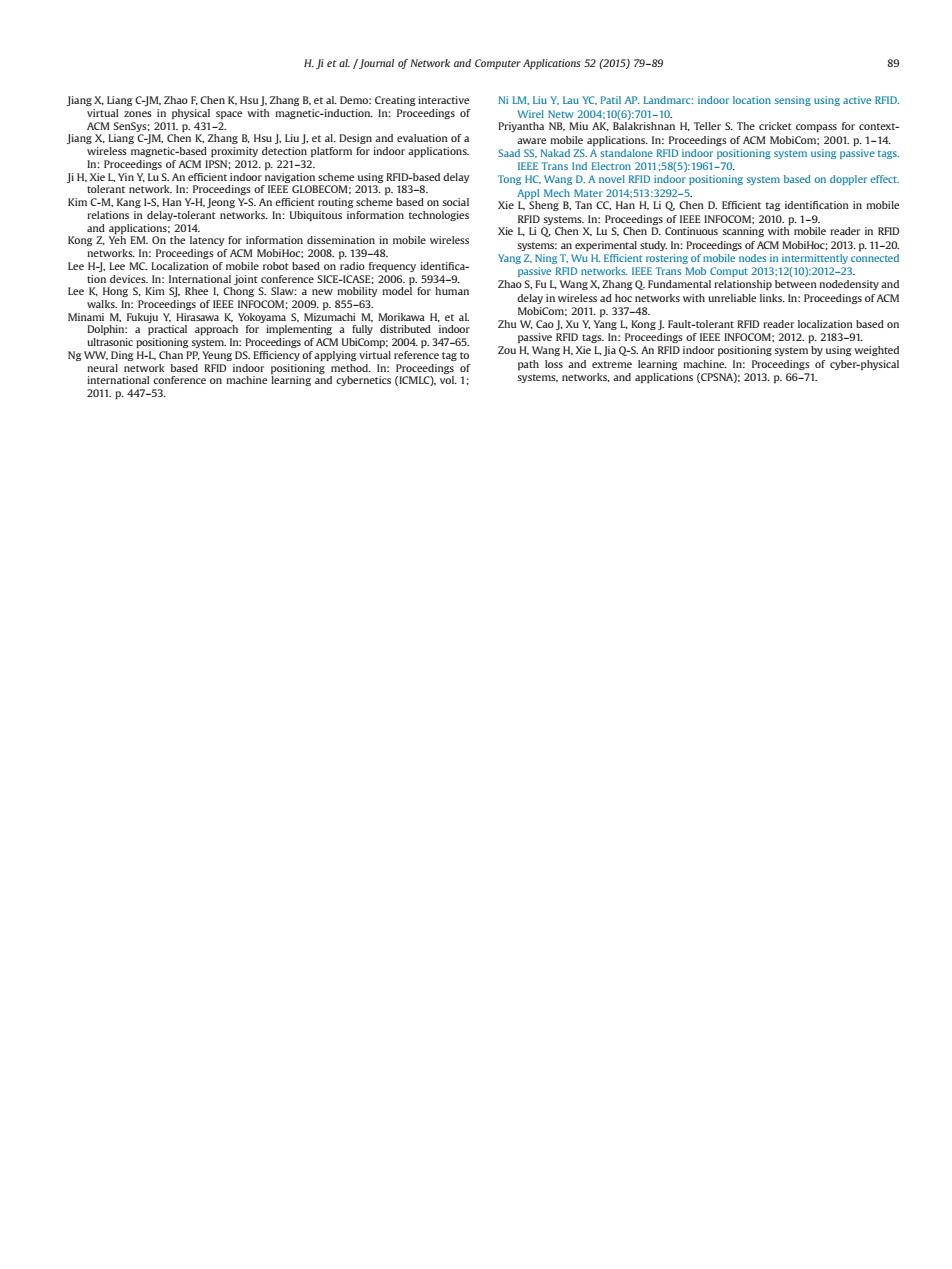正在加载图片...

H.Ji et al Journal of Network and Computer Applications 52 (2015)79-89 89 Jiang X,Liang C-JM,Zhao F.Chen K.Hsu J.Zhang B.et al.Demo:Creating interactive Ni LM,Liu Y.Lau YC.Patil AP.Landmarc:indoor location sensing using active RFID. virtual zones in physical space with magnetic-induction.In:Proceedings of Wirel Netw2004:10(6:701-10. ACM SenSys:2011.p.431-2. Priyantha NB.Miu AK,Balakrishnan H,Teller S.The cricket compass for context- Jiang X.Liang C-JM,Chen K,Zhang B.Hsu J.Liu J.et al.Design and evaluation of a aware mobile applications.In:Proceedings of ACM MobiCom:2001 p.1-14. wireless magnetic-based proximity detection platform for indoor applications. Saad SS.Nakad ZS.A standalone RFID indoor positioning system using passive tags In:Proceedings of ACM IPSN:2012.p.221-32. IEEE Trans Ind Electron 2011:58(5):1961-70. Ji H.Xie L Yin Y.Lu S.An efficient indoor na vigation scheme using RFID-based delay Tong HC.Wang D.A novel RFID indoor positioning system based on doppler effect. tolerant network.In:Proceedings of IEEE GLOBECOM:2013.p.183-8. Appl Mech Mater 2014:513:3292-5. Kim C-M,Kang I-S.Han Y-H.Jeong Y-S.An efficient routing scheme based on social Xie L Sheng B.Tan CC.Han H.Li Q,Chen D.Efficient tag identification in mobile relations in delay-tolerant networks.In:Ubiquitous information technologies RFID systems.In:Proceedings of IEEE INFOCOM:2010.p.1-9. and applications:2014. Xie L Li Q,Chen X.Lu S.Chen D.Continuous scanning with mobile reader in RFID Kong Yeh EM.On the latency for information dissemination in mobile wireless networks.In:Proceedings of ACM MobiHoc:2008.p.139-48. systems:an experimental study.In:Proceedings of ACM MobiHoc:2013.p.11-20. Lee H-J.Lee MC.Localization of mobile robot based on radio frequency identifica- Yang Z.Ning T.Wu H.Efficient rostering of mobile nodes in intermittently connected passive RFID networks.IEEE Trans Mob Comput 2013:12(10):2012-23. tion devices.In:International joint conference SICE-ICASE:2006.p.5934-9. Lee K,Hong S.Kim SI.Rhee I,Chong S.Slaw:a new mobility model for human Zhao S,Fu L Wang X,Zhang Q.Fundamental relationship between nodedensity and walks.In:Proceedings of IEEE INFOCOM;2009.p.855-63. delay in wireless ad hoc networks with unreliable links.In:Proceedings of ACM Minami M.Fukuju Y.Hirasawa K,Yokoyama S.Mizumachi M,Morikawa H,et al. MobiCom:2011.p.337-48. Dolphin:a practical approach for implementing a fully distributed indoor Zhu W.Cao J.Xu Y.Yang L,Kong J.Fault-tolerant RFID reader localization based on ultrasonic positioning system.In:Proceedings of ACM UbiComp:2004.p.347-65. passive RFID tags.In:Proceedings of IEEE INFOCOM:2012.p.2183-91. Ng WW.Ding H-L Chan PP.Yeung DS.Efficiency of applying virtual reference tag to Zou H.Wang H.Xie L Jia Q-S.An RFID indoor positioning system by using weighted neural network based RFID indoor positioning method.In:Proceedings of path loss and extreme learning machine.In:Proceedings of cyber-physical international conference on machine learning and cybernetics (ICMLC).vol.1; systems,networks,and applications(CPSNA):2013.p.66-71. 2011.p.447-53.Jiang X, Liang C-JM, Zhao F, Chen K, Hsu J, Zhang B, et al. Demo: Creating interactive virtual zones in physical space with magnetic-induction. In: Proceedings of ACM SenSys; 2011. p. 431–2. Jiang X, Liang C-JM, Chen K, Zhang B, Hsu J, Liu J, et al. Design and evaluation of a wireless magnetic-based proximity detection platform for indoor applications. In: Proceedings of ACM IPSN; 2012. p. 221–32. Ji H, Xie L, Yin Y, Lu S. An efficient indoor navigation scheme using RFID-based delay tolerant network. In: Proceedings of IEEE GLOBECOM; 2013. p. 183–8. Kim C-M, Kang I-S, Han Y-H, Jeong Y-S. An efficient routing scheme based on social relations in delay-tolerant networks. In: Ubiquitous information technologies and applications; 2014. Kong Z, Yeh EM. On the latency for information dissemination in mobile wireless networks. In: Proceedings of ACM MobiHoc; 2008. p. 139–48. Lee H-J, Lee MC. Localization of mobile robot based on radio frequency identification devices. In: International joint conference SICE-ICASE; 2006. p. 5934–9. Lee K, Hong S, Kim SJ, Rhee I, Chong S. Slaw: a new mobility model for human walks. In: Proceedings of IEEE INFOCOM; 2009. p. 855–63. Minami M, Fukuju Y, Hirasawa K, Yokoyama S, Mizumachi M, Morikawa H, et al. Dolphin: a practical approach for implementing a fully distributed indoor ultrasonic positioning system. In: Proceedings of ACM UbiComp; 2004. p. 347–65. Ng WW, Ding H-L, Chan PP, Yeung DS. Efficiency of applying virtual reference tag to neural network based RFID indoor positioning method. In: Proceedings of international conference on machine learning and cybernetics (ICMLC), vol. 1; 2011. p. 447–53. Ni LM, Liu Y, Lau YC, Patil AP. Landmarc: indoor location sensing using active RFID. Wirel Netw 2004;10(6):701–10. Priyantha NB, Miu AK, Balakrishnan H, Teller S. The cricket compass for contextaware mobile applications. In: Proceedings of ACM MobiCom; 2001. p. 1–14. Saad SS, Nakad ZS. A standalone RFID indoor positioning system using passive tags. IEEE Trans Ind Electron 2011;58(5):1961–70. Tong HC, Wang D. A novel RFID indoor positioning system based on doppler effect. Appl Mech Mater 2014;513:3292–5. Xie L, Sheng B, Tan CC, Han H, Li Q, Chen D. Efficient tag identification in mobile RFID systems. In: Proceedings of IEEE INFOCOM; 2010. p. 1–9. Xie L, Li Q, Chen X, Lu S, Chen D. Continuous scanning with mobile reader in RFID systems: an experimental study. In: Proceedings of ACM MobiHoc; 2013. p. 11–20. Yang Z, Ning T, Wu H. Efficient rostering of mobile nodes in intermittently connected passive RFID networks. IEEE Trans Mob Comput 2013;12(10):2012–23. Zhao S, Fu L, Wang X, Zhang Q. Fundamental relationship between nodedensity and delay in wireless ad hoc networks with unreliable links. In: Proceedings of ACM MobiCom; 2011. p. 337–48. Zhu W, Cao J, Xu Y, Yang L, Kong J. Fault-tolerant RFID reader localization based on passive RFID tags. In: Proceedings of IEEE INFOCOM; 2012. p. 2183–91. Zou H, Wang H, Xie L, Jia Q-S. An RFID indoor positioning system by using weighted path loss and extreme learning machine. In: Proceedings of cyber-physical systems, networks, and applications (CPSNA); 2013. p. 66–71. H. Ji et al. / Journal of Network and Computer Applications 52 (2015) 79–89 89